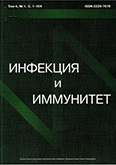Том 4, № 1 (2014)
- Год: 2014
- Дата публикации: 09.07.2014
- Статей: 6
- URL: https://iimmun.ru/iimm/issue/view/16
- DOI: https://doi.org/10.15789/2220-7619-2014-1
ОБЗОРЫ
ОБЩИЕ ЗАКОНОМЕРНОСТИ ФОРМИРОВАНИЯ И ПОДДЕРЖАНИЯ СПЕЦИФИЧЕСКОГО ГУМОРАЛЬНОГО ИММУННОГО ОТВЕТА НА ПРИМЕРЕ ОТВЕТА НА ВИРУСЫ КОРИ И КРАСНУХИ
Аннотация
Резюме. Т-фолликулярные хелперы (Tfh) — одна из субпопуляций CD4+ Т-хелперов, осуществляющая контроль антигенспецифического В-клеточного иммунитета. При первом контакте с примированной антигеном В-клеткой, Tfh может поддержать либо экстрафолликулярный путь развития В-клетки в короткоживущую плазматическую клетку (РС), либо вхождение В-клетки в лимфоидный фолликул для формирования зародышевого центра (GC). Взаимодействие Signaling lymphocytic activation molecule (SLAM) между Tfh и активированной В-клеткой необходимо для развития GC. Внутри GC Tfh регулирует направление развития антигенспецифических GC В-клеток, экспрессирующих высокоаффинные В-клеточные рецепторы, либо в сторону В-клеток памяти (Bm), либо долгоживущих РС. Короткоживущие РС продуцируют низкоаффинные IgM и IgG3 ранние антитела. Как Bm, так и долгоживущие РС имеют высокоаффинные IgA и IgG, преимущественно IgG1-антитела. Вирус кори использует SLAM-молекулу в качестве клеточного рецептора. SLAM экспрессируется на дендритных клетках и активированных В- и Т-клетках и является одним из важных регуляторов переключения изотипов и созревания аффинитета, особенно IgG3-IgG1 переключения. Развитие длительного гуморального иммунитета, характеризующегося формированием высокоаффинных, преимущественно IgG1-антител, является необходимым компонентом формирования защитного иммунитета против патогенов, и по существу, главной целью вакцинации. Однако механизмы, вовлеченные в формирование и поддержание длительного гуморального иммунного ответа остаются недостаточно изученными.
 7-14
7-14


ВОЗДЕЙСТВИЕ НА КЛЕТОЧНЫЕ МИШЕНИ КАК СРЕДСТВО БОРЬБЫ С ГРИППОЗНОЙ ИНФЕКЦИЕЙ
Аннотация
Резюме. Грипп представляет собой высоко контагиозное заболевание человека. На фоне использования противовирусных препаратов формируются лекарственно-устойчивые штаммы вируса, следствием чего является снижение эффективности этиотропной химиотерапии. В обзоре рассмотрены способы снижения уровня репликации вируса и тяжести патологического процесса, основанные на использовании альтернативных мишеней не вирусного, а клеточного происхождения. Описаны препараты, снижающие продукцию провоспалительных цитокинов (эриторан), ограничивающие дегрануляцию тучных клеток (кетотифен), ингибиторы циклооксигеназ (целекоксиб, месалазин, SC-560), ингибиторы сфингозин-1-фосфатного пути (AAL-R), а также повышающие стабильность сосудов путем упрочения контактов между эндотелиальными клетками (белок Slit). Особое внимание уделено ингибиторам клеточных путей, используемых вирусом для повышения репродукции, таких как NF-kB, Raf/MEK/ERK, PI3K/AKT/mTOR. Описана противогриппозная активность ингибиторов киназ и процесса аутофагии, а также препаратов смешанного механизма действия — глицирризиновой кислоты и дипептида α-глутамилтриптофана. Дальнейшие исследования в области поиска и оптимизации ингибиторов клеточных компонентов как средств против гриппозной инфекции могут привести к разработке новых противовирусных препаратов высокой эффективности, широкого спектра действия и низкой вероятности развития резистентности.
 15-26
15-26


ЭНТЕРОВИРУСНАЯ ИНФЕКЦИЯ: МНОГООБРАЗИЕ ВОЗБУДИТЕЛЕЙ И КЛИНИЧЕСКИХ ФОРМ
Аннотация
Резюме. Энтеровирусы являются широко распространенными возбудителями инфекционных заболеваний человека. Несмотря на то, что в большинстве случаев инфицирование не влечет за собой заболевание, у некоторых инфицированных может наблюдаться широкий спектр симптомов: от признаков простуды до серозного менингита и миокардита. В редких случаях энтеровирусы вызывают тяжелые заболевания с летальным исходом. Большое значение для здравоохранения представляет способность энтеровирусов становиться возбудителями вспышек и эпидемий энтеровирусной инфекции. Учитывая высокую генетическую изменчивость энтеровирусов, в будущем возможно появление их новых высокопатогенных штаммов. В ряде стран, в том числе в Российской Федерации, помимо программы ВОЗ, направленной на ликвидацию полиомиелита, проводится постоянный эпидемиологический надзор за энтеровирусными инфекциями. Лабораторная диагностика энтеровирусных инфекций осложняется большим количеством серотипов возбудителя, поэтому наряду с классическими вирусологическими методами в диагностике используют молекулярно-биологические методы, позволяющие секвенировать геном возбудителя и определить филогенетические связи между различными штаммами энтеровирусов.
 27-36
27-36


ОРИГИНАЛЬНЫЕ СТАТЬИ
СИНТЕЗ ЦИТОКИНОВ IN VITRO ПРИ ИНФЕКЦИИ КУЛЬТУРЫ КЛЕТОК ЧЕЛОВЕКА ВИРУСОМ КЛЕЩЕВОГО ЭНЦЕФАЛИТА И В ПРИСУТСТВИИ ИНАКТИВИРОВАННОЙ ВАКЦИНЫ
Аннотация
Резюме. Клещевой энцефалит (КЭ) — нейроинфекционное вирусное заболевание, в патогенезе которого иммунные механизмы играют существенную роль. Проведен сравнительный анализ синтеза ключевых цитокинов при инфекции ВКЭ и в присутствии инактивированной вакцины против КЭ in vitro. При инфекции перевиваемой культуры клеток рака гортани человека HEp-2 ВКЭ наблюдали активацию транскрипции IFNα, IFNγ, IFNλ1, IL-1β, IL-2, IL-4, IL-8, IL-10, IL-12, TNFα и одного из факторов апоптоза Fas. Сравнение транскрипции и продукции цитокинов показало, что в результате вирусной инфекции баланс Th1/Th2 смещался в сторону Th1 на посттранскрипционном уровне. В присутствии инактивированной вакцины против КЭ, основанной на том же штамме Софьин ВКЭ, также происходила активация транскрипции цитокинов IFNα, IFNλ1, IL-4, IL-10, как и в результате инфекции штаммом Софьин ВКЭ, а также продукция GM-CSF, что свидетельствует об индукции преимущественно Th2 пути. Впервые показано участие IFN III-типа (IFNλ1) при инфекции культур клеток ВКЭ и добавлении вакцины против КЭ. Получены доказательства различия в динамике синтеза цитокинов IL-2, IL-8, IL-10, IL-12, TNFα при инфекции ВКЭ, а также при действии инактивированной вакцины против КЭ.
 37-42
37-42


КРАТКИЕ СООБЩЕНИЯ
СПЕКТР ВОЗБУДИТЕЛЕЙ БАКТЕРИЕМИИ У ПАЦИЕНТОВ С ИММУНОДЕФИЦИТНЫМИ СОСТОЯНИЯМИ РАЗЛИЧНОГО ПРОИСХОЖДЕНИЯ
Аннотация
Резюме. Проведен сравнительный анализ результатов бактериологического исследования проб крови, полученных от 1608 пациентов с вторичным иммунодефицитом разного происхождения. Установлено, что в спектре возбудителей бактериемии у пациентов онкоурологического профиля преобладают энтеробактерии, у пациентов после трансплантации печени — микромицеты, а у раненых и пострадавших с тяжелыми травмами — стафилококки.
 43-48
43-48


МАТЕРИАЛЫ НАУЧНО–ПРАКТИЧЕСКОЙ КОНФЕРЕНЦИИ
 49-99
49-99











